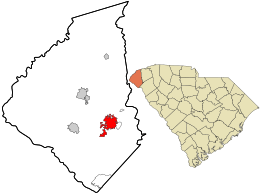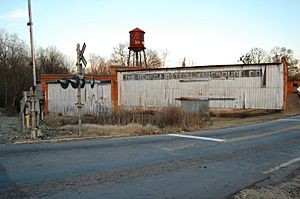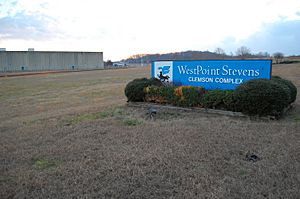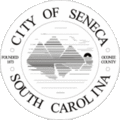Seneca, South Carolina facts for kids
Quick facts for kids
Seneca, South Carolina
|
|||
|---|---|---|---|

Seneca City Hall
|
|||
|
|||
| Motto(s):
"City of Smiles, City with Style"
|
|||

Location in Oconee County and the state of South Carolina.
|
|||
| Country | United States | ||
| State | South Carolina | ||
| County | Oconee | ||
| Area | |||
| • Total | 8.30 sq mi (21.49 km2) | ||
| • Land | 8.24 sq mi (21.35 km2) | ||
| • Water | 0.05 sq mi (0.14 km2) | ||
| Elevation | 951 ft (290 m) | ||
| Population
(2020)
|
|||
| • Total | 8,850 | ||
| • Density | 1,073.64/sq mi (414.55/km2) | ||
| Time zone | UTC−5 (Eastern (EST)) | ||
| • Summer (DST) | UTC−4 (EDT) | ||
| ZIP codes |
29672, 29678, 29679
|
||
| Area codes | 864, 821 | ||
| FIPS code | 45-65095 | ||
| GNIS feature ID | 1250833 | ||
Seneca is a city located in Oconee County, South Carolina, in the United States. In 2020, about 8,850 people lived there.
Seneca is the main city of the Seneca Micropolitan Statistical Area. This area includes all of Oconee County. It is also part of the larger Greenville-Spartanburg-Anderson area. The city was named after a nearby Cherokee town called Isunigu, which was known to English settlers as "Seneca Town."
Contents
History of Seneca
Seneca was founded in 1873, right after the American Civil War. It started as a railroad town called "Seneca City." It got its name from the Seneca River and the historic Cherokee town of Isunigu.
How Seneca City Began
Seneca City grew at a special spot where two railroads crossed. These were the Blue Ridge Railroad and the new Atlanta and Charlotte Air Line Railroad. Today, both of these lines are part of the Norfolk Southern Railway.
A. W. Thompson and J. J. Norton, who were engineers for the Air Line Railroad, bought the land. They marked the center of the new town where the railroad tracks met Townville Street. The land was then divided into lots for building. An auction was held on August 14, 1873, to sell these lots. The town officially became a city with a charter from the state on March 14, 1874. In 1908, the name was shortened to just Seneca.
Growth and Industry
Seneca became an important place for selling and shipping cotton. Cotton was a major crop grown in this area. Wagons full of cotton would line up for blocks near the railroad station during harvest time. A passenger station, hotels, and a park were built close to the tracks. This park is now called Norton-Thompson Park, named after the city's founders.
The first school in Seneca was built in 1874. The community also had the Seneca Institute - Seneca Junior College. This college was started in 1899 for African-American students and operated until 1939.
Textile mills, which make fabric, were also built nearby. One large mill village was created in 1893 in Newry. It used water power from the Little River. Another textile plant was built east of Seneca. These mills were the main jobs for Seneca for many years. However, most of these mills have now closed because jobs moved to other countries.
Modern Development and Lakes
In the late 1900s, big dams were built on local rivers. These projects created three large lakes: Lake Hartwell in 1963, Lake Keowee in 1971, and Lake Jocassee in 1974. These lakes helped Seneca and the area grow. Duke Power's Oconee Nuclear Station was built on Lake Keowee. It uses water from the lake to help cool its operations.
The lakes offer many fun activities like boating and fishing. Also, Clemson University is nearby. These attractions have brought many retired people to live in the area. Some residents formed a group called Friends of Lake Keowee Society (FOLKS). They work to make sure the area develops in a balanced way.
In April 2020, a strong tornado hit areas south and east of Seneca. It caused a lot of damage to buildings and sadly, one person died.
Historic Places in Seneca
Several historic buildings and areas in and around Seneca are listed on the National Register of Historic Places. This means they are important to history and are protected.
- Seneca Historic District was added in 1974. It has homes and churches built in the late 1800s and early 1900s.
- Ram Cat Alley Historic District was listed in 2000. This area has twenty-one commercial buildings from the 1880s to the 1930s. The street got its name because cats used to gather around a meat market there. Many of these buildings are now restaurants, shops, and offices.
- Newry Historic District was listed in 1982. It is a historic village that grew around a textile mill near Seneca.
- Other important historic places include:
- Alexander-Hill House
- Faith Cabin Library at Seneca Junior College
- McPhail Angus Farm
- Old Pickens Presbyterian Church
Geography of Seneca
Seneca is located at 34.684145 degrees North latitude and -82.955778 degrees West longitude.
The United States Census Bureau says that the city covers about 7.1 square miles (18.4 square kilometers). Most of this area is land, with a small part being water.
Population of Seneca
The population of Seneca has grown over the years:
| Historical population | |||
|---|---|---|---|
| Census | Pop. | %± | |
| 1880 | 382 | — | |
| 1900 | 920 | — | |
| 1910 | 1,313 | 42.7% | |
| 1920 | 1,460 | 11.2% | |
| 1930 | 1,929 | 32.1% | |
| 1940 | 2,155 | 11.7% | |
| 1950 | 3,649 | 69.3% | |
| 1960 | 5,227 | 43.2% | |
| 1970 | 6,027 | 15.3% | |
| 1980 | 7,436 | 23.4% | |
| 1990 | 7,726 | 3.9% | |
| 2000 | 7,652 | −1.0% | |
| 2010 | 8,102 | 5.9% | |
| 2020 | 8,850 | 9.2% | |
| U.S. Decennial Census 2020 |
|||
People in Seneca (2020)
In 2020, there were 8,850 people living in Seneca. There were 4,043 households and 2,138 families.
| Race | Number of People | Percentage |
|---|---|---|
| White (not Hispanic) | 5,556 | 62.78% |
| Black or African American (not Hispanic) | 2,143 | 24.21% |
| Native American | 25 | 0.28% |
| Asian | 108 | 1.22% |
| Pacific Islander | 3 | 0.03% |
| Other/Mixed | 484 | 5.47% |
| Hispanic or Latino | 531 | 6.0% |
Education and Learning
Seneca has a lending library. It is a part of the Oconee County Public Library system.
Until June 2020, Seneca was home to the National Council of Examiners for Engineering and Surveying (NCEES). This group creates exams for engineers and surveyors. The NCEES later moved to Greenville, South Carolina.
Notable People from Seneca
Many interesting people have come from Seneca, including:
- Jimmy Orr – A retired professional football player who won the Super Bowl.
- Willie Aikens – A former Major League Baseball player.
- Bennie Cunningham – A former professional football player.
- John Edwards – A former U.S. Senator from North Carolina and a candidate for Vice President in 2004.
- Lindsey Graham – A U.S. Senator from South Carolina since 2003.
- Clarence Kay – A former professional football player.
- Marshall Parker – A politician.
- Marv Rackley – A former Major League Baseball player.
- Needtobreathe – A popular Christian rock band.
Images for kids
See also
 In Spanish: Seneca (Carolina del Sur) para niños
In Spanish: Seneca (Carolina del Sur) para niños













